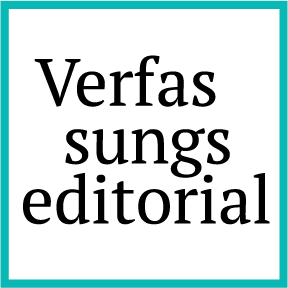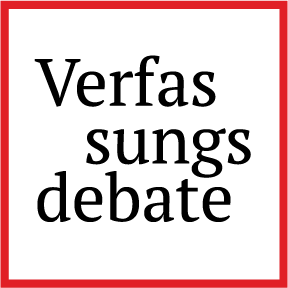Crisis and Legal Scholarship
In Search of New (Meta-)Narratives?
References to crisis abound. Since the 2008 financial crash and with the popularisation of the term “polycrisis” after the COVID-19 pandemic, the idea that we live in times of crises shapes public opinion, political discourse, and academic debates (some influential examples in legal scholarship here, here and recently here). Take, for instance, the publications on this blog. A review of posts published in the period 01 January 2025 to 31 July 2025 reveals an average of 15 posts per month mentioning some kind of crisis. “Rule of law crisis”, “refugee crisis”, “political crisis”, “constitutional crisis”, “debt crisis”, “security crisis”, “energy crisis”, “economic crisis”, “climate crisis”, “time of crisis”, “EU’s existential crisis” – along with their German equivalents – appear repeatedly in this year’s Verfassungsblog publications. Crisis is certainly a catchword, and these “are hard to resist”. But does the pervasiveness of this term tell us something about the kind of knowledge produced by legal scholarship?
This post is not concerned with the essence of the notion of crisis (i.e., how different authors define it) but rather with its implications for legal scholarship. It highlights three interrelated dimensions – temporalities, distributive patterns, and aesthetics – that demonstrate how the narrative of crisis influences (1) the kind of questions asked, (2) the type of scholarship produced, and (3) the tone of academic conversation. To illustrate this, I will refer to labour law scholarship, a field of legal inquiry shaped by the narrative of crisis for over 40 years.
Crisis as Organising Temporalities
Crisis alters our perception of time. It establishes an event that marks a turning point or point-zero in history – what Janet Roitman has called “moments of truth”. In doing so, it creates a sequence of past (non-crisis) / crisis (point-zero) / future (post-crisis). Linearity is, therefore, a central effect of “crisis” as an organising principle of time.
This has clear implications for legal scholarship. When “crisis” is invoked, research questions often focus on its causes (past), on describing the situation (point-zero), and/or on offering potential responses (future). This framing channels legal inquiry into a primary path of casualty, which can be characterised as: diagnose – anomaly – solutions.
In labour law scholarship, claims of a crisis emerged in the 1980s, when scholars identified a mismatch between the model of work relationship the law relies upon (employment under conditions of industrialisation during the mid-20th century in North-Atlantic societies) and the realities of work today. Indeed, contemporary work dynamics are cut across macro-trends ranging from the transnationalization of production, the fissuring of workplaces, the relevance of the informal economy, and changes in the political subjectification of labour, to mention just a few. Notably, the narrative of crisis gained centrality in the field at a time when claims regarding the end of history, and specifically, the end of work, were put forward by authors as different as Habermas, Rifkin, and Gorz.
The view of labour law as being in crisis has spawned extensive scholarship that typically describes the characteristics of the crisis, examines its emergence, and propose paths to overcome it (for example, here and here). However, framing the pre-1980s as a period of non-crisis is misleading. As early as 1932, Hugo Sinzheimer – one of the foundational figures of the discipline – published the article Die Krisis des Arbeitsrecht (see here and Dukes here). This publication came in a very peculiar historical juncture: the end of the Weimar Republic in Germany and, notably, the seminal adoption of labour laws across the globe.
The way the term crisis has evolved within labour law suggests that the tensions and contradictions scholars seek to capture by employing this term might not indicate a disruption or an anomaly within a seamless, coherent, and linear view of legal change, but are rather built into its very fabric. Tensions and contradictions inject dynamism into the legal field, creating space for reflexivity and recalibration. Beyond labour law, similar observations have been made in constitutional and EU law, where the concept of crisis is examined not as mere exceptionalities or anomalies, but as something inherent to modernity (see Kjaer’s chapter here, and more broadly here). This indicates that legal change unfolds in non-linear patterns, challenging the straightforward temporalities of “crisis”. As Shakespeare wisely noted, time is out of joint.
The Distributive Effects of Crisis
On a material level, the concept of “crisis” allows for exceptional responses and measures to be adopted. This means that framing a situation as a crisis enables prioritising actions and allocating resources in ways that would not be acceptable or would have to be strongly justified in non-crisis conditions. This argument has already been explored in this blog by examining the EU Commission responses to migration flows across the EU-Belarusian border. More broadly, the narrative of a “migration crisis” in Europe has led to a proliferation of techniques for assessing individuals’ socioeconomic positions and consequently their right to enter and stay in Europe. Additionally, research indicates a link between economic crises and negative attitudes towards immigration in Europe, partly explained by pervasive stereotypes that claim migrants “steal” jobs from locals and exert downward pressure on wages. In all these contexts, law plays a crucial role (see here and here).
The distributive effects of “crisis” also surface quite neatly when we focus on labour law. During economic crises, arguments on the need to “stabilise the economy” are elaborated as justifications to dismantle labour laws in the pursuit of reducing the costs associated with labour as a factor of production. Even though the debate over the correlation between curtailing labour rights and achieving market efficiency remains contentious, these arguments periodically resurface. This is evident in the connection between the failed labour market deregulation initiatives of structural adjustment programmes in the 1990s, and the revival of these proposals in Europe following the 2008 financial crisis (see here and here). These initiatives failed to prevent job losses, leading to an increase in unemployment and insecure working conditions. This exemplifies the dramatic social effects of austerity measures implemented in response to the 2008 financial crisis, which have been thoroughly documented (for example, here, here and here). Labour rights – alongside other social rights, such as health, food and housing – were a central adjustment variable in many institutional responses to the crisis. This underscores the fact that when “crisis” is invoked it often signals the need for actors to make sacrifices in the interest of society – although some must make more sacrifices than others.
The Aesthetics of Crisis
Using Rancière‘s notion of aesthetics as the distribution of the sensible – i.e., aesthetics as comprising the operations that order our perception –, we can identify a specific aesthetics in the narrative of crisis. Crisis shapes our perception around a sense of lack of time. It triggers emotions that range from nostalgia (longing for the pre-crisis state) to paralysis, expressed in sentiments such as, there is nothing we can do about this, which notably seem to feature prominently among international lawyers today. In politics, crisis creates an atmosphere of uncertainty, fear, and anxiety, providing fertile ground for the rise of authoritarian tendencies. In legal scholarship, a final significant risk of the aesthetics of crisis is perhaps scepticism towards the respective field itself, which, in its more acute forms, can manifest as a claim for abandonment. Let’s see this at play in labour law.
As argued above, framing labour law as being in crisis has dominated debates in the field since the 1980s. Paralysis manifests as the inability to move beyond the idea of crisis, even among analysts who do not entirely agree with the terminology. Crisis remains the point-zero, and its totalising effects are hard to circumvent.
The crisis narrative also nurtured scepticism towards the field itself. This manifested in concerns regarding a supposed “death of labour law” (here and here), and proposals to abandon its traditional (i.e., historical) form. The perils of such views become particularly evident when considering the distributive effects reviewed above. Even if unintentional, these views portray labour laws as outdated, ineffective or rigid, thereby aligning with proposals anchored in neoclassical economics advocating for modernisation and flexibility in labour laws. The aesthetic dimension of “crisis” thus not only shapes the tone of the academic conversation infusing it with a sense of urgency, but it is also directly linked to the distributive and temporal dimensions previously presented.
New Meta–Narratives or Different Research Questions?
The range of potential implications arising from the analysis above exceeds the scope of this post. Nevertheless, I believe the core consequence is methodological, and once, again, labour law may provide food for thought.
As a distinct field of legal knowledge, labour law emerged from recognising a specific social conflict: the different positions that workers and employers occupy in the economic structuring of society. This generated an imbalance of power within the work relation, which had to be legally mediated. From this, labour law aimed to provide mechanisms of collective mediation to temporarily stabilise this conflict, which – under existing circumstances – cannot be resolved. The illustrative example is collective bargaining. In the framework of a collective negotiation, an employer and a trade union sit at a table and negotiate the price of labour power, and perhaps some additional working conditions. Does this solve the problem of value extraction through labour exploitation in market societies? No, it does not. It provides a temporary solution – a stabilisation of that conflict – that, on the one hand, drains social conflictivity (i.e., prevents the conflict from breaking out openly, although it does not disappear; it remains in a state of latency) and, on the other, reflects the balance of power between the actors of that conflict at that specific moment in time. Eventually, that same employer and union will sit at that same table to negotiate again wages and working conditions. This is precisely why questions of democracy cannot be detached from analyses of labour law. Negotiation and conflict as generative rather than as “negative” are ideas that are just as fundamental for analysing legalities governing work relations as for analysing political praxis in general. Herein lies the dynamic character of labour law.
The contemporary narrative of crisis overlooks this dynamic character. Conflicts and social processes are fluid to the extent that the idea of a mismatch (crisis) can be, as previously noted, considered part of the historical unfolding of the legal field, which encompasses practices of reflexivity and recalibration.
An alternative path to the meta-narrative – or “super concept”/Oberbegriff – of crisis could thus potentially involve taking up labour law’s original methodological gesture: to identify a particular conflict in society, to recognise the actors in that conflict, and to establish means of temporal stabilisation for it. This essentially means setting aside the premise of an original non-conflictual state of normalcy, stability, and coherent homogeneity as an assumed starting point for legal inquiry. In the realm of international law scholarship, there is now an express acknowledgement of the need to move beyond the narrative of crisis, and this is motivating, for example, critiques of the field’s perception of time, in line with some of our earlier arguments. In constitutional law, this has prompted a need to frame current crisis debates within broader historical frameworks. Similarly, EU legal scholars are calling for a revitalization of the dialectical relationship between crisis and critique to advance a transformative approach to methods in legal scholarship. This all paves the way for a plethora of research questions that diverge significantly from those we can formulate when the analysis begins with “the crisis in/of…”. It encourages an exploration of the connections, assemblies and disruptions of events, rather than a search for causal certainty.
Going back to the beginning of this post, we could start by asking: What would happen if we removed all mentions of “crisis” from the posts published on this blog during these months? How might we then characterise the situations previously described under that label? Could this removal open up new debates – if so, which? Most importantly, what new directions for analysis might emerge once the word “crisis” is out of the picture?




What an original and stimulating post! As someone thinking on the climate *crisis*, I will definitely have to think on this one for a while. But your post opens a range of new questions to ask (myself). Thank you!